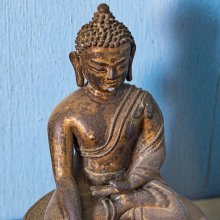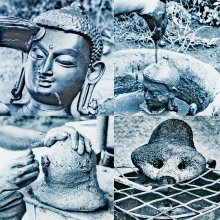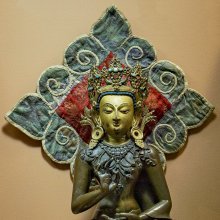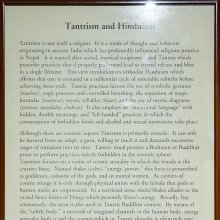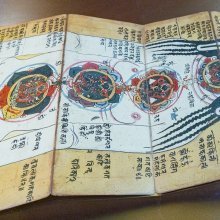Channel: 2 definitions
Introduction:
Channel means something in Hinduism, Sanskrit. If you want to know the exact meaning, history, etymology or English translation of this term then check out the descriptions on this page. Add your comment or reference to a book if you want to contribute to this summary article.
Images (photo gallery)
(+2 more images available)
In Hinduism
Ayurveda (science of life)
Source: INSA Digital Repository: Caraka’s Approach to KnowledgeChannel (Sanskrit: srōtas) in Ayurveda refers to the “countless channels which cris-cross the body” (bounded by the skin outside and the alimentary canal inside).—The channels and the accumulated doshas blocking them were not visible to the physician except in his ‘mind’s eye’; and the idea of loosening the dosha plugs by the ingestion of a fat-based preparation and the elimination of the accumulated doshas which would flow into the alimentary canal by emesis or purgation was untested.

Āyurveda (आयुर्वेद, ayurveda) is a branch of Indian science dealing with medicine, herbalism, taxology, anatomy, surgery, alchemy and related topics. Traditional practice of Āyurveda in ancient India dates back to at least the first millenium BC. Literature is commonly written in Sanskrit using various poetic metres.
Yoga (school of philosophy)
Source: ORA: Amanaska (king of all yogas): A Critical Edition and Annotated Translation by Jason BirchThe Channels (Veins) of the body are denoted by the Sanskrit term Sirā, according to the Amaraughaprabodha: a short 13th century treatise on Yoga attributed to Gorakṣanātha which teaches the fourfold system of yoga (Mantra, Laya, Haṭha and Rāja).—Accordingly, “[...] Some who are skilled in circulating the breath through the channels of the entire body, consume dhātus [...] They do not have mastery of the body without [the state of] Rājayoga, in which their minds are absent. When the mind has attained equanimity and the breath moves into the central channel (sirā), [then] these Amarolī, Vajrolī and Sahajolī [Mudras] arise”.

Yoga is originally considered a branch of Hindu philosophy (astika), but both ancient and modern Yoga combine the physical, mental and spiritual. Yoga teaches various physical techniques also known as āsanas (postures), used for various purposes (eg., meditation, contemplation, relaxation).
See also (Relevant definitions)
Full-text (+1019): Pranali, Srotas, Somasutra, Sushumna, Pingala, Nadi, Sarani, Pranalika, Sira, Panalika, Shuddhi, Tayvaykkal, Karnapatha, Khancani, Jalancala, Pamshumarddana, Durapatra, Paranali, Tatini, Usabhamukha.
Relevant text
Search found 173 books and stories containing Channel; (plurals include: Channels). You can also click to the full overview containing English textual excerpts. Below are direct links for the most relevant articles:
Yoga-sutras (Ancient and Modern Interpretations) (by Makarand Gopal Newalkar)
Sūtra 4.3 < [Book IV - Kaivalya-pāda]
Sūtra 1.7 < [Book I - Samādhi-pāda]
Sūtra 2.7-8 [Rāga—attachment and Dveśa—aversion] < [Book II - Sādhana-pāda]
Chapter XIII - The Nature Of The Oceans
Chapter XVIII - The Nature Of Trees
Trishashti Shalaka Purusha Caritra (by Helen M. Johnson)
Part 10: Sermon on saṃvara < [Chapter VIII - Śītalanāthacaritra]
Part 18: Sermon on the Tattvas < [Chapter IV - Anantanāthacaritra]
Tattva 5: Āśrava (channels for acquisition of karma) < [Appendix 1.4: The nine tattvas]
Egypt Through The Stereoscope (by James Henry Breasted)
Position 91 - The Great Assuan Dam (northwest) From The First Pylon Of The Philae Temple < [Standpoints In Egypt]
Position 98 - Second Cataract Of The Nile, From The Southwest, The First Obstruction To Navigation For A Thousand Miles < [Standpoints In Egypt]
Position 86 - The Nilometer, The Measurer Of Inundations, Island Of Elephantine, First Cataract < [Standpoints In Egypt]
Sushruta Samhita, volume 3: Sharirasthana (by Kaviraj Kunja Lal Bhishagratna)
Chapter IX - The description of the arteries, nerves and ducts
Chapter IV - The development of a fetus in the womb
Amaravati Art in the Context of Andhra Archaeology (by Sreyashi Ray chowdhuri)
Coastal and Maritime trade < [Chapter 4 - Survival of Amarāvatī in the Context of Andhra Art]
The flourishing agriculture and prosperity in Amarāvatī (Dhānyakaṭaka) < [Chapter 4 - Survival of Amarāvatī in the Context of Andhra Art]
